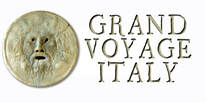|
The culture in Italy is very different than in the U.S... especially concerning rules of proper behavior. What is acceptable in the States might be considered disgusting in Italy. What Italians consider as normal behavior, we would never thing of doing at home. Here are a few differences...  Popular tissues in Italy Popular tissues in Italy
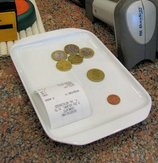 Pick up your change Pick up your change
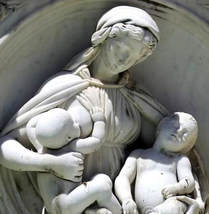
 It's Chilly down there It's Chilly down there
--GVI 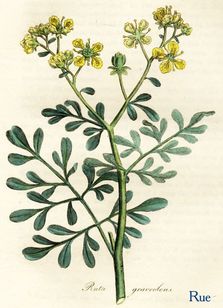 The cimaruta is a very old Italian portafortuna (good luck charm) rooted in the lore of the ancient Pagan religions of Italy. It can be worn around the neck or hung above an infant's bed to ward off any evil. Like many of the lasting ancient symbols and beliefs, the cimaruta design eventually took on certain symbols of Catholicism. One example of a Christian addition to the design is the appearance of "the sacred heart" of Jesus. However, ancient Roman charms did include a heart symbol, which may indicate that the heart on the cimaruta isn't an entirely new addition. The traditional cimaruta is fashioned after the leafy sprig of rue, which is an herb that is highly featured in Italian magic and lore. The branch of the rue is divided into three stems symbolizing the three forms of the goddess Diana. Rue was a sacred herb for Diana. Various charms appear on the rue design, each having its own meaning. The main symbols are the moon, serpent, and key. These represent the goddess as Hecate (the key), Diana (the moon) and Proserpina (the serpent). There may also be a rose; a hand holding either a wand or a sword; a flaming heart; a fish or dolphin (a nod to Diana); an owl (to flirt with the Devil); a plumed medieval helmet; a vervain blossom (a flower from Italian fairy ore); a cherub; a rooster (watchful guardian); and an eagle (able to see evil coming from far away). One cimaruta, for example, might bear the collective imagery of a key, dagger, blossom and moon. The cimaruta is worn nowadays more by women than men. 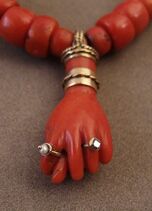 Mano in Fica The clenched fist with a trusting thumb is known as mano in fica or simply, mano figa ("fig-hand"), or far le fiche ("c*nt gesture", pardon the profanity), for the resemblance to female genitalia. The word figa itself is a very vulgar word to describe a vagina in Italy. Such a rude hand gesture was common in past centuries, similar to "giving the finger" or "flipping the bird", but has fallen out of use. Dante's Divine Comedy (Inferno, Canto XXV) mentions the mano in fica. Supposedly, this charm is used to insult the devil and others casting evil spells. 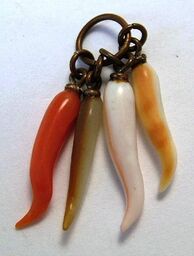 Cornetto The cornetto, shaped like a horn or chili pepper, is still popular in Southern Italy around Naples, Calabria and in the rest of Mezzogiorno (southern Italy). In Calabria and Naples this charm is worn as jewelry, hung on rear view mirrors, hung in shop windows, on key rings, and on t-shirts. It is more effective if it is red (representing an enemy's blood) and topped with a crown (representing wealth). The cornetto is a symbol of virility (obvious with its phallic shape), but it also brings luck, wealth, success and can also used by women. A similar magical horn of plenty was carried by the Roman Goddess Abundantia to represent abundance, and many think the cornetto has its roots in ancient Roman times.  Mano Corno An alternative to the cornetto, some claim the Mano Corno can ward off the malocchio (evil eye). However, in Italy, the Mano Corno can be seen as offensive... this hand gesture is called cornuto, or a cuckolded man. Give this hand sign to an Italian man and you are basically calling him weak, pathetic and unmanly. This sign--along with sticking up a middle finger--are the most insulting signs you can insult an Italian man with. This charm directly insults the devils and his demons himself. 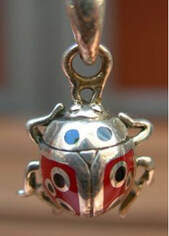 Coccinella The Coccinella, or ladybug (ladybird) charm brings luck in the arena of love and romance. it's a very common charm in Italy, especially with women. The red color has multiple meanings... red represents victory over one's enemies (spilling their blood); red helps ward off malocchio; and red also is the color of passion and romance. Another fact about the ladybug is they eat the bad bugs who would eat a farmer's crops, so of course they came to be thought of as a sign of good luck, helping prevent crop failure.
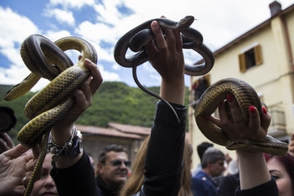 When I was a kid, we would occasionally find a garter snake living in our small urban garden along with our collection of 15 box turtles. I always loved snakes... smooth, silky, muscular and graceful. On our country property today, I've often seen several species of snakes: garter, ribbon, black rat. The hill behind our home is called Rattlesnake Hill, but I've never seen one. I still find it interesting when I come across snakes... but I don't honor them in any way and couldn't dream of anyone holding a festival for them! 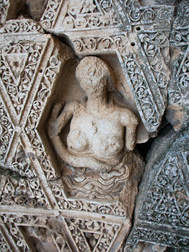 Ancient Roman temple to Angitia Ancient Roman temple to Angitia Yet, each year in the beginning of May, in the small towns of Cocullo and Villalag0, La Festa dei Serpari is held. The festival is held in honor of Saint Dominic, protector of toothache, reptile bites and rage. But the festival also has ancient pagan roots in honor of the Oscan healer and snake goddess, Angizia. Also known as Angitia to the ancient Romans, she was revered by the Marsi, a warlike tribe of people who lived to the east of Rome in the Apennine Mountains. 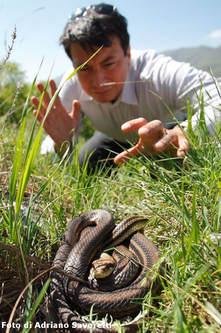 Separi reaching for his catch Separi reaching for his catch Angizia possessed an ability to heal those who had been poisoned--especially by snakes--and had the power to kill serpents by casting verbal spells. First century Romans knew the Marsi region contained many healers, magicians, and snake-charmers was infamous as a hotbed of witchcraft. The Festa dei Separi honors the modern-day separi (snake wranglers), with many of them catching and contributing snakes to the festivities. In preparation for the Festival, during the last half of March, the separi spread out across the countryside in their hunt for snakes. Once captured, they are carefully stored in wooden boxes, or as in ancient times, inside terracotta containers for 15-20 days. The snakes are fed a healthy diet of live mice and hard-boiled eggs. 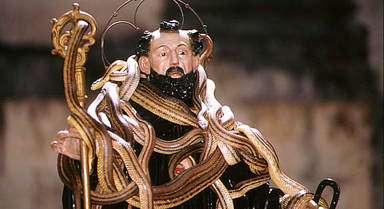 On the day of the festival, pilgrims gather in the church of San Domenico to be healed. After Mass, the statue of the Saint is draped with live snakes and carried into the piazza where believers gather to touch both the Saint and the snakes for their healing powers. The local separi also drape themselves with snakes and follow the procession. In years past, the snakes were killed afterwards and eaten in a feast, but now the bread is substituted, formed into various snake shapes... interlocking rings of snakes, biting their tails, or as serpents with sliced almond scales and coffee bean eyes. The snakes are no longer killed, but released back into the wild when the festival is over. 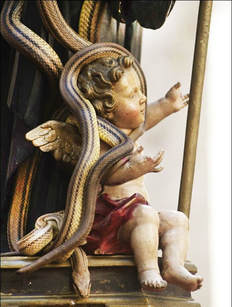 Some other scholars argue that the festival dates back even further to the Greek hero and god, Hercules. Supposedly, jealous Hera sent two snakes to kill him in his crib. The infant Hercules was unusually strong and fearless and strangled the snakes before they could strangle him. In the nearby hamlet of Casale votive bronzes representing Hercules have been found. Saint Domenico himself is particularly revered in Cocullo because some personal relics are kept in the church there: a molar and a horseshoe from his mule. Villalag0 also has one of his molars. There is no telling who has the rest of his teeth. Perhaps they were eaten--by snakes. --GVI  In the United States, May Day isn't really a holiday at all. All we know about it is when people with roots from Germanic countries celebrate the return of summer with children dancing around the ribboned May Pole. We also know it as a day of marches for left-wing or worker political parties promoting their agendas for various worker's rights, similar to how workers in many countries treat May Day. In Italy, the 1st of May is called Festa dei Lavoratori (Workers' Day), similar to American's Memorial Day or Labor Day. While there might still be workers marching and holding protests depending on which way the the political and economic wind is blowing, for most workaday furbo Italians, it's simply a day off from work and a long weekend to go to the beach, attend one of the many rock concerts, have a barbecue or rent a holiday cabin in the mountains. After all, it's a lot of work to organize and protest on hot city streets, isn't it? Easier to just go to the beach and throw some steaks on the grill. Most museums are closed as well as many other shops for the entire holiday weekend. This is perhaps not the best weekend to visit major tourist destinations in Italy simply because this is one of the holiday weekends where Italians do the tourist thing... just the way Americans might visit tourist sites in the States during Memorial Day or Labor Day weekends. 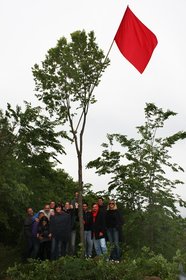 Red flag raised on maypole at Appignano del Tronto Red flag raised on maypole at Appignano del Tronto Still, in some parts of Italy (southern Marche, for example) a red flag is placed at the top of a poplar tree as a Socialist party symbol. If you're overly anti-communist, don't get paranoid... Italian socialists--and communists--mix well with other Italians and tourists alike. You might meet them later on during the weekend at the beach... Have a great May Day! --Jerry Finzi |
On AMAZON:
|



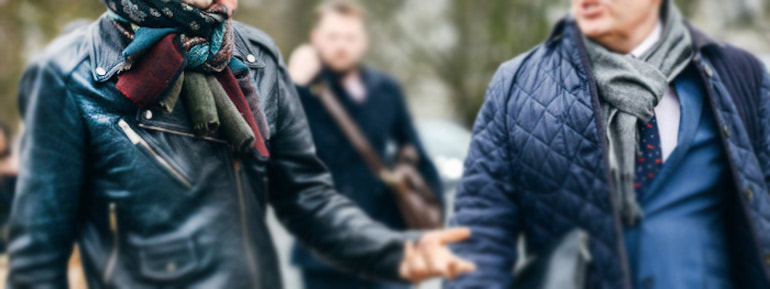
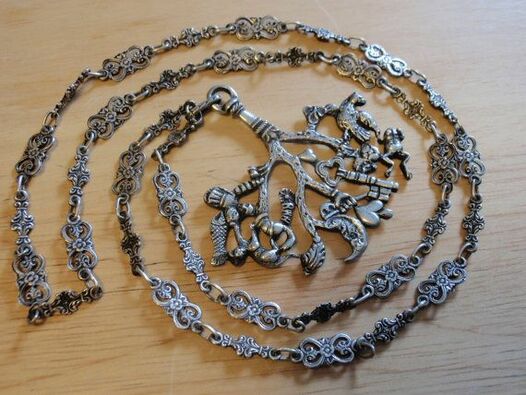
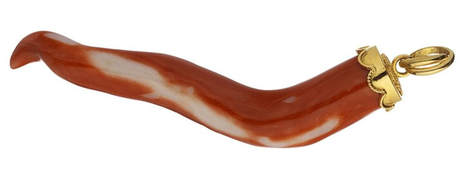
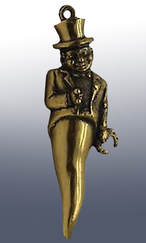
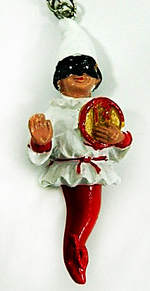
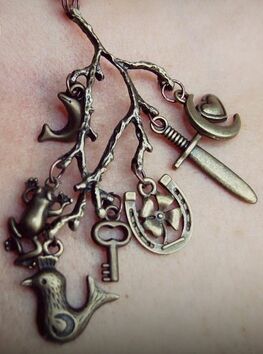
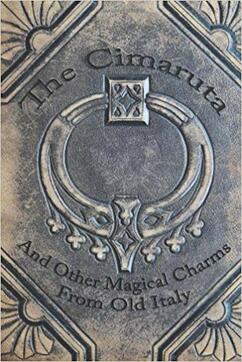
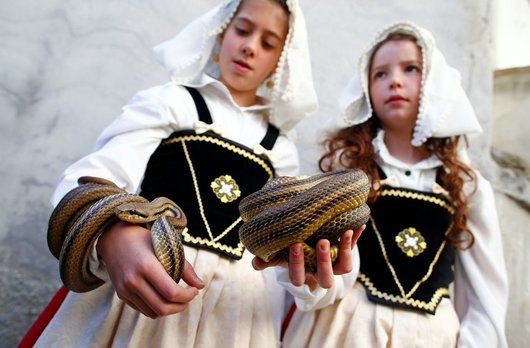
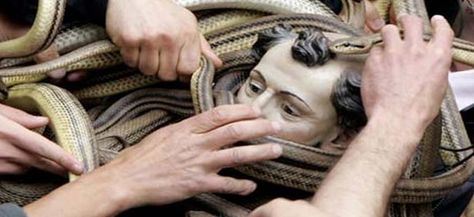

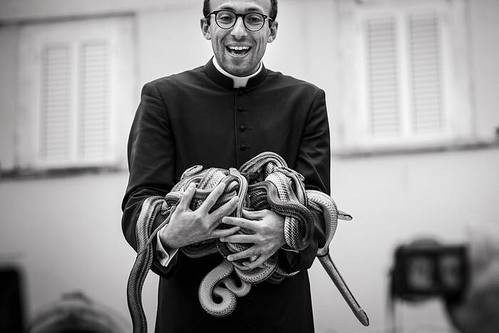

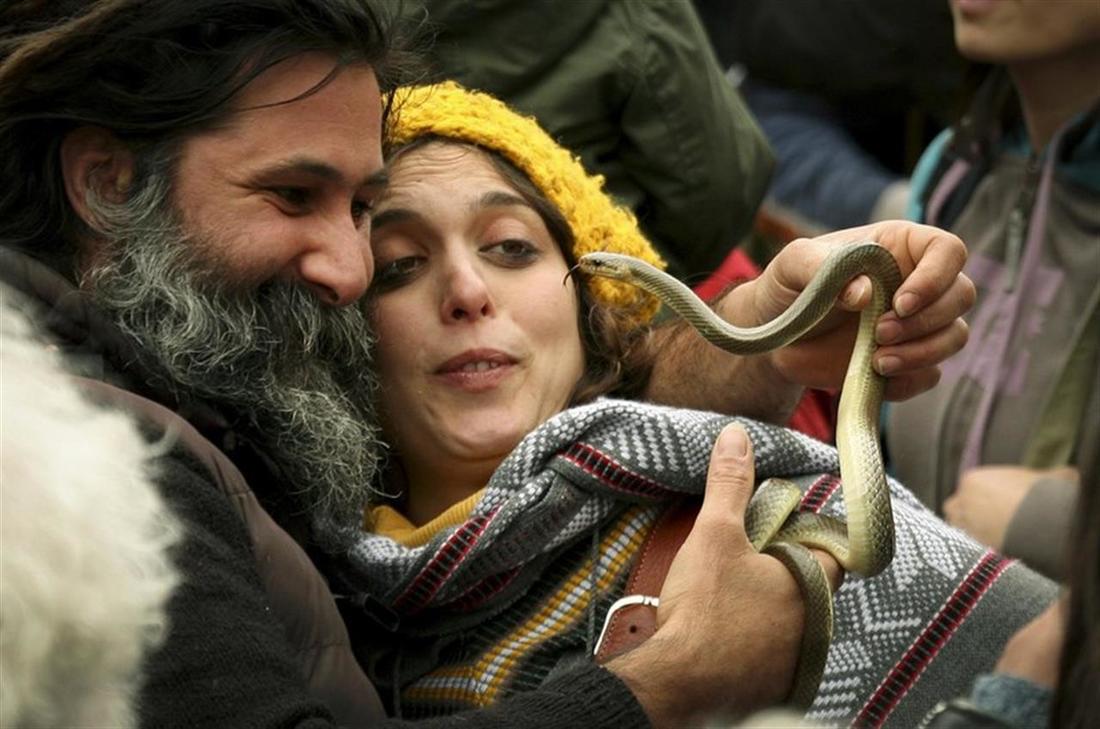
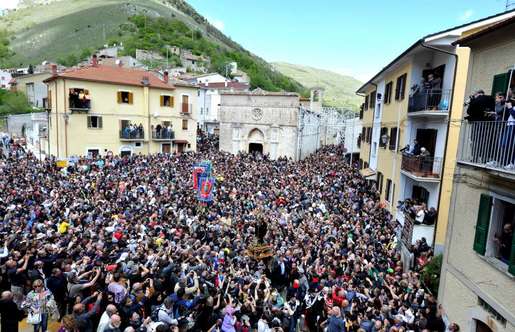

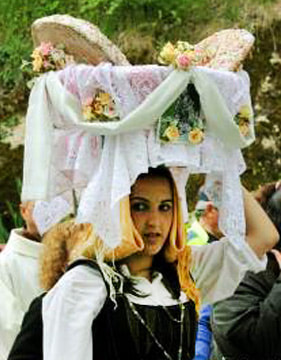
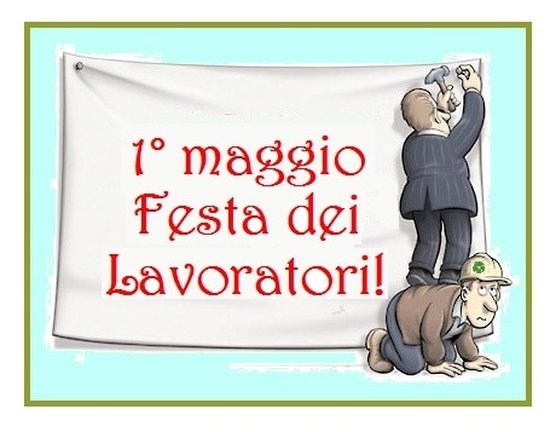
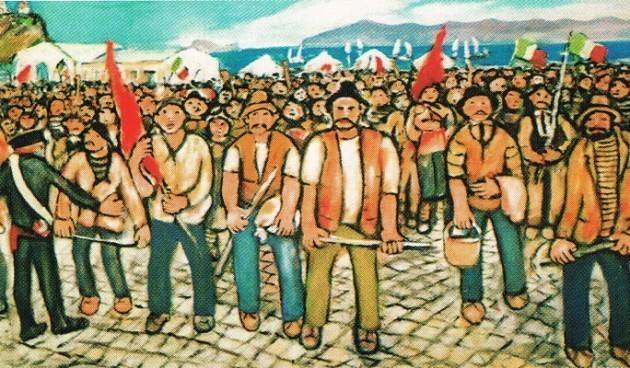

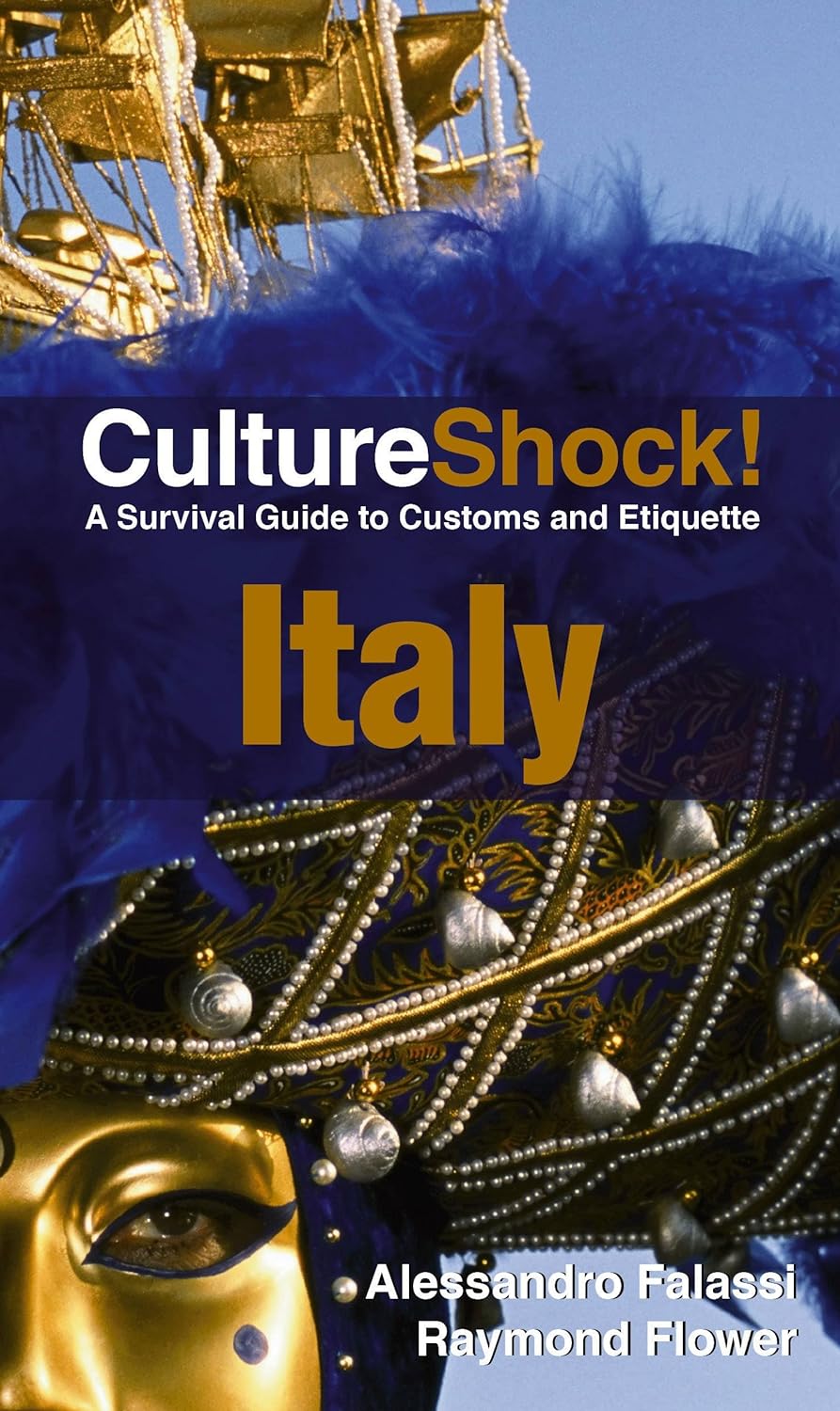
 RSS Feed
RSS Feed

